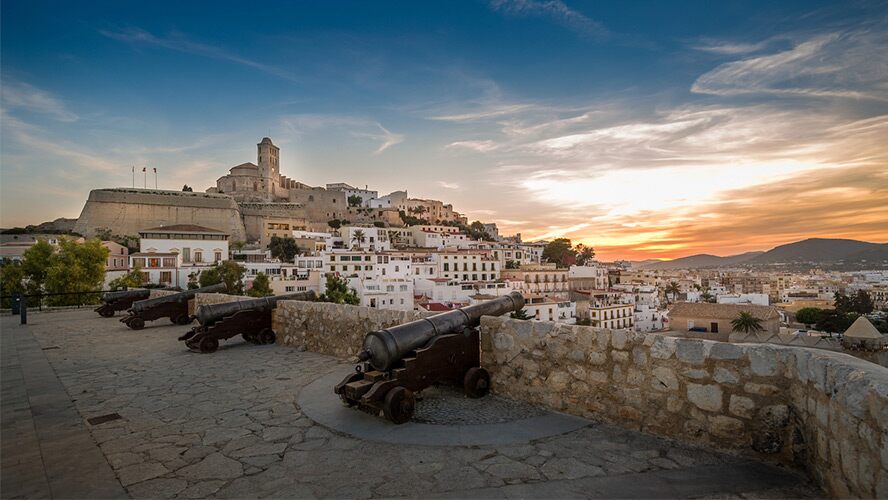
Ibiza, the white island of the Mediterranean , is much more than a common tourist destination . Immerse yourself in its fascinating history and discover its surprising biodiversity that makes it unique in the world, due to its characteristic white and soft architecture , it is a paradise for lovers of history and culture . Ibiza, the largest of the Pitiusas (Ibiza and Formentera) , has a rich cultural heritage that can be seen throughout its geography.

Discover the Charm of Ibiza
In the heart of the municipality of Ibiza stands its capital , an architectural jewel recognized worldwide as a World Heritage Site by UNESCO since 1999. The acropolis of Dalt Vila, with its intricate alleys, the majestic Castle and the imposing Cathedral , transport you to centuries of history and culture. The old Renaissance wall with its seven bastions embrace Dalt Vila , the true heart of Ibiza. Considered the best preserved coastal fortress in the Mediterranean , this citadel was declared a World Heritage Site by UNESCO , and inside there are both the Cathedral of Santa María de las Nieves, the Plaza de la Vila and the Mirador del Rey Jaume I , such as the Ibiza Museum of Contemporary Art . An essential visit to learn about the creative explosion since the 60s of the 20th century by local and international authors.
The defense towers , which surround the island and were built in the 16th century to protect it from pirate raids. Today, many of these towers have been restored and can be visited , such as the Torre des Savinar , in the Es Vedrà natural park , which offers stunning panoramic views of the Mediterranean Sea and the cliffs . Ibiza also includes an important artistic and musical heritage. The island is famous for its festivals and cultural events, such as the Ibiza Medieval Fair or the Ibiza Music Festival , which attracts musicians and lovers of the performing arts from all over the world. Ibiza is a benchmark in cultural heritage , from its ancient walls and defensive towers, to its more cosmopolitan side as a center of creativity, such as its examples of the Bauhaus movement and Dadism .

Emblematic places
The Phoenician vestiges of Sa Caleta and the Phoenician-Punic Necropolis of Puig des Molins are exceptional testimonies of the urbanization and social life of ancient Phoenician colonies . These sites are a valuable source of knowledge about the origins and evolution of the Phoenician and Carthaginian cultures.
The Phoenician town of Sa Caleta is located in the municipality of Sant Josep, on a small peninsula known as sa Mola de sa Caleta , between the es Codolar beach and the Puig des Jondal.
Its discovery and excavation has been very important because it provides data from the most archaic phase of the Phoenician colonization of Ibiza . It must have been a large population center. Its origin possibly dates back to the 8th century BC , becoming denser in the middle of the 7th century BC by Phoenicians from the Peninsula and it was inhabited for about fifty years . It was abandoned peacefully around 590 BC , according to archaeological remains, to move to the bay of Ibiza .
The site is presented as a motley set of buildings of different sizes and shapes that weave a network of narrow streets and small, irregular squares . The platform of a possible communal bread oven and remains of buildings that possibly served as a warehouse and metallurgical ovens are preserved.
To the left of sa Mola de sa Caleta there is a small port , probably also created by the Phoenicians . Phoenician colonization is documented mainly at this site and in the archaic necropolis of Puig des Molins .
The Necropolis is located on a hill located in the center of the current city of Ibiza , not far from the historic center. It is located relatively close to the Puig de Vila , because it was common in Phoenician cities for the areas between life and death to not be very far away.
Puis des Molins is the oldest and most important necropolis in Ibiza and the one that has provided a numerous and diverse set of materials. The most abundant element is the Punic hypogea , which consist of a rectangular access well and an underground chamber , generally quadrangular in shape. Externally only about 350 are visible ; However, the real number is estimated at around 3000 graves .

Protected Nature
The UNESCO committee has highlighted the privileged nature of Ibiza, considering it a unique enclave for its biodiversity and natural values. The island is home to Posidonia oceanica meadows , an underwater ecosystem that contributes to the purity of the surrounding waters and is crucial for the preservation of the environment.
The seabed of the islands of Ibiza and Formentera are home to the largest living organism in the world, extensive Posidonia Oceanica meadows eight kilometers long and more than 100,000 years old , declared World Heritage by UNESCO .
This underwater forest , which extends from Es Freus (Formentera) to Ses Salines beach (Ibiza ), is the habitat of numerous species and is responsible for the transparency and turquoise color of the waters of Ibiza and Formentera , making them one one of the best places in the Mediterranean for diving.
Among the posidonia live numerous species that find food and protection here, a safe environment to mate and lay eggs , where the young grow up in a kind of nursery with abundant food . One of them is the seahorse (Hippocampus ramulosus ), with its chess piece shape camouflaging itself in search of small invertebrates and larvae . Numerous small fish also live here, such as bream, damselfish and scorpionfish , among many others.

A Destination to Captivate
Ibiza has been selected as a treasure that deserves to be protected and preserved for future generations . This Mediterranean island, with its fascinating history and surprising biodiversity , continues to captivate those who have the privilege of exploring it, being a living testimony to the richness and diversity of world heritage.

Come and discover the magic of Ibiza!

